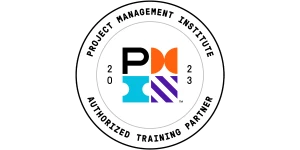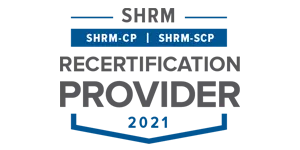Mastering Qualitative Risk Analysis: A Comprehensive Guide for Modern Project Managers
Risk management stands as a crucial element in project success, with qualitative risk analysis serving as the foundation for effective risk evaluation and mitigation.
This systematic approach helps project managers and risk professionals identify, assess, and prioritize potential risks based on their probability and impact.
Qualitative risk analysis offers a structured framework for understanding and managing risks without requiring complex mathematical calculations or extensive historical data.
Key Highlights
- Risk Assessment Methods and Core Techniques
- Probability and Impact Matrix Applications
- Digital Tools for Risk Analysis
- Team-Based Risk Response Planning Strategies
- Modern Risk Management Implementation Steps
What Is Qualitative Risk Analysis?
Qualitative risk analysis forms an essential part of project risk management, enabling teams to evaluate and prioritize risks based on their probability and potential impact.
This method helps project managers make informed decisions about risk responses without requiring complex mathematical calculations or extensive historical data.
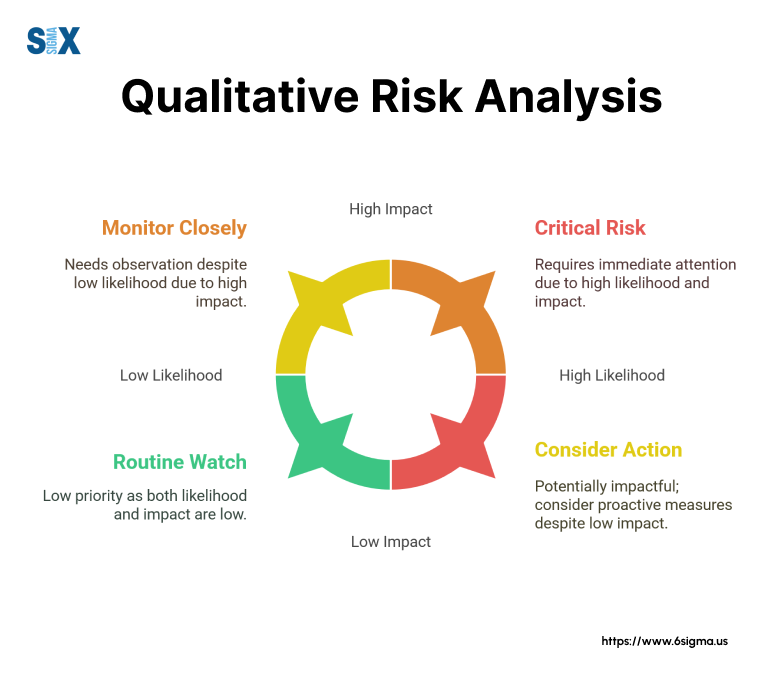
Purpose and Goals
The primary purpose of qualitative risk analysis is to assess project risks systematically and determine their relative importance.
Project teams use this analysis to identify which risks need immediate attention and which can be monitored over time.
Key goals of qualitative risk analysis include:
- Prioritizing identified risks for further analysis or action
- Evaluating probability and impact of risk occurrence
- Determining which risks require detailed quantitative analysis
- Creating a foundation for developing risk response plans
Comparison With Quantitative Risk Analysis
While qualitative risk analysis focuses on subjective assessment and categorization, quantitative risk analysis deals with numerical data and statistical analysis.
Here’s how they differ:
Qualitative Risk Analysis:
- Uses descriptive scales (high, medium, low)
- Relies on expert judgment and experience
- Requires minimal mathematical calculations
- Provides quick assessment results
- Works well with limited historical data
Quantitative Risk Analysis:
- Uses numerical values and probabilities
- Requires statistical analysis tools
- Demands detailed historical data
- Produces specific numerical outcomes
- Takes longer to complete
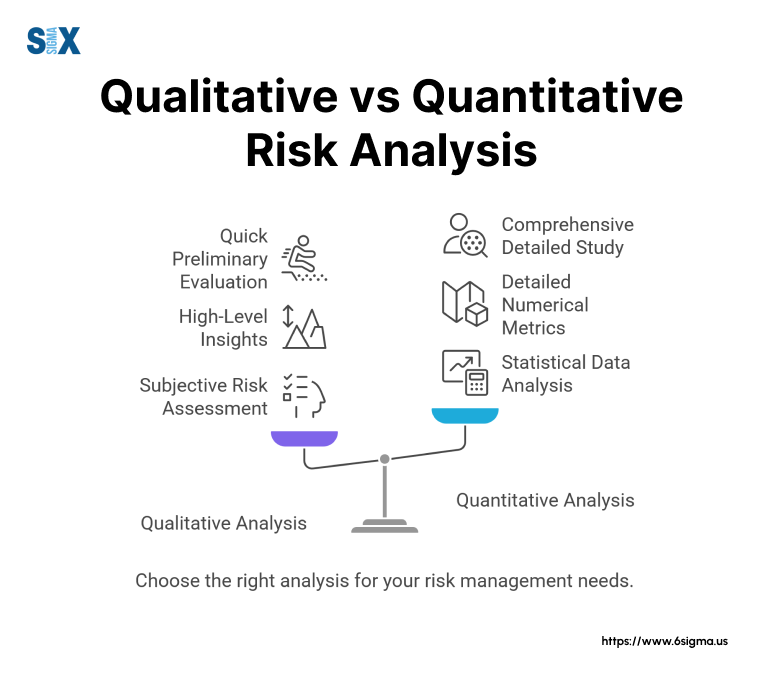
When to Use Qualitative Risk Analysis
Project managers should implement qualitative risk analysis in several scenarios:
Early Project Stages: Use it during initial planning to quickly identify major risk areas.
Limited Resources: Apply this method when time or budget constraints prevent detailed quantitative analysis.
Rapid Assessment Needs: Deploy it for fast decision-making about risk priorities.
Stakeholder Communication: Utilize it to explain risk levels to non-technical stakeholders.
The effectiveness of qualitative risk analysis depends on the project context and available information.
For small to medium-sized projects, this approach often provides sufficient insight for risk management decisions.
Larger projects might use it as an initial screening tool before conducting more detailed quantitative analysis.
Implementation Considerations of Qualitative Risk Analysis
Modern project environments require adaptable risk analysis approaches. Digital tools now support remote team collaboration during risk assessment sessions.
These tools help standardize the evaluation process and maintain consistency across different project phases.
Project managers should consider environmental and social factors when conducting qualitative risk analysis.
These elements have become increasingly important in risk assessment frameworks, reflecting changing business priorities and stakeholder expectations.
Build a Strong Foundation in Risk Management with Lean Six Sigma Green Belt Training
Lean Six Sigma in Qualitative Risk Analysis
Qualitative risk analysis provides a systematic approach for project teams to identify, assess, and prioritize risks based on their probability and impact, allowing for informed decision-making.
By focusing on qualitative methods, the article emphasizes the importance of stakeholder input and expert judgment in the absence of extensive historical data.
Qualitative risk analysis helps organizations navigate uncertainties by providing quick assessments and facilitating communication among team members and stakeholders.
It is particularly relevant in industries such as construction, IT, and healthcare, where risks can significantly impact timelines, budgets, and quality.
Core Connection to Relevant Principles
PMBOK (Project Management Body of Knowledge) and PRINCE2 aligns with this methodology, which emphasize the need for risk management processes.
It underscores the importance of qualitative techniques that enable project managers to make strategic decisions early in the project lifecycle.
Within the Lean Six Sigma framework, qualitative risk analysis contributes to reducing waste and variation by identifying potential risks that may lead to non-compliance or process inefficiencies.
By integrating qualitative assessments with Lean Six Sigma principles, organizations can enhance their overall processes, ensuring a proactive approach to risk identification and response planning.
Application in Practice
The concepts of qualitative risk analysis can be applied in various real-world scenarios.
For instance, in a software development project, project managers can utilize risk assessment workshops to gather feedback from cross-functional teams about potential risks such as user adoption challenges or technical integration issues.
By employing a probability and impact matrix, they can prioritize these risks and develop targeted mitigation strategies, leading to smoother implementation.
Additionally, in infrastructure projects, teams can conduct brainstorming sessions to identify environmental and regulatory risks early in the Define phase.
Benefits for Practitioners
Understanding qualitative risk analysis offers significant benefits for practitioners at different levels:
- Green Belts: They can leverage qualitative risk analysis to quickly assess project risks and implement responses, thereby contributing to successful project outcomes without deep statistical data analysis.
- Black Belts: They can employ qualitative techniques to facilitate risk identification sessions and integrate them into broader Six Sigma projects. This enhances their ability to drive team discussions focused on quality improvement while addressing identified risks.
- Master Black Belts: For Master Black Belts, qualitative risk analysis provides a framework to mentor teams, ensuring that risk management is embedded in project planning. They can utilize this knowledge to influence organizational strategies regarding risk management practices and ensure alignment with overall business objectives.
The Qualitative Risk Analysis Process
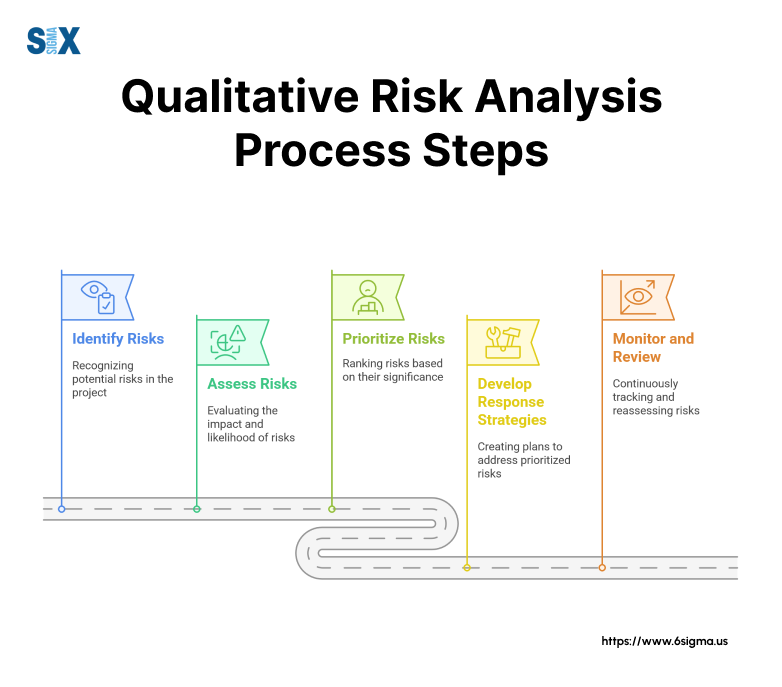
The qualitative risk analysis process follows a structured approach that enables project teams to identify, assess, and respond to potential risks effectively.
Each step builds upon the previous one, creating a robust framework for risk management.
Step 1: Risk Identification
Risk identification starts with gathering input from project stakeholders, subject matter experts, and historical project data.
Project teams should examine both internal and external factors that might affect project objectives.
During this phase, teams document potential risks in a risk register, including:
- Technical challenges and dependencies
- Resource availability concerns
- Market conditions and economic factors
- Regulatory requirements and changes
- Stakeholder expectations and conflicts
Modern digital tools help teams collaborate remotely during risk identification sessions, ensuring diverse perspectives are captured and documented properly.
Step 2: Risk Assessment
The assessment phase evaluates each identified risk based on two primary factors: probability of occurrence and potential impact on project objectives.
Teams typically use predefined scales (such as high, medium, low) to rate these factors.
Project managers should consider multiple impact areas:
- Schedule delays and milestone impacts
- Budget overruns and cost implications
- Quality standards and deliverable specifications
- Resource availability and allocation
- Stakeholder satisfaction levels
Step 3: Risk Prioritization
Risk prioritization involves ranking risks based on their assessment scores.
Teams use probability and impact matrices to determine which risks require immediate attention and which can be monitored over time.
Key prioritization criteria include:
- Overall risk score (probability × impact)
- Project constraints and objectives
- Available resources for risk response
- Organizational risk tolerance levels
- Strategic importance of affected areas
Step 4: Risk Response Planning
Response planning develops specific strategies for addressing prioritized risks. Teams must select appropriate response strategies:
- Avoidance: Eliminating risk causes or changing project plans
- Mitigation: Reducing probability or impact of risks
- Transfer: Shifting risk responsibility to third parties
- Acceptance: Acknowledging and monitoring minor risks
Digital Integration and Monitoring with Qualitative Risk Analysis
Modern project management tools support continuous monitoring of the qualitative risk analysis process. These platforms enable:
- Real-time risk status updates
- Automated notification systems
- Team collaboration features
- Documentation management
- Performance tracking metrics
Project managers should regularly review and update risk assessments as new information becomes available or project conditions change.
This ongoing process helps maintain the effectiveness of risk management strategies throughout the project lifecycle.
Environmental and social risks require special attention in today’s project environment. Teams should consider sustainability impacts and social responsibility factors when developing risk response strategies.
Tools and Techniques for Qualitative Risk Analysis
Project managers employ various tools and techniques to conduct effective qualitative risk analysis.
These methods help teams evaluate and prioritize risks while maintaining consistency across different projects and organizations.
Risk Probability and Impact Matrix
The probability and impact matrix serves as a fundamental tool for qualitative risk analysis. This matrix plots risks based on their likelihood of occurrence and potential impact on project objectives.
Project teams typically use a 5×5 matrix structure with color-coded zones:
- Red zone: High-priority risks requiring immediate attention
- Yellow zone: Medium-priority risks needing regular monitoring
- Green zone: Low-priority risks that can be tracked periodically
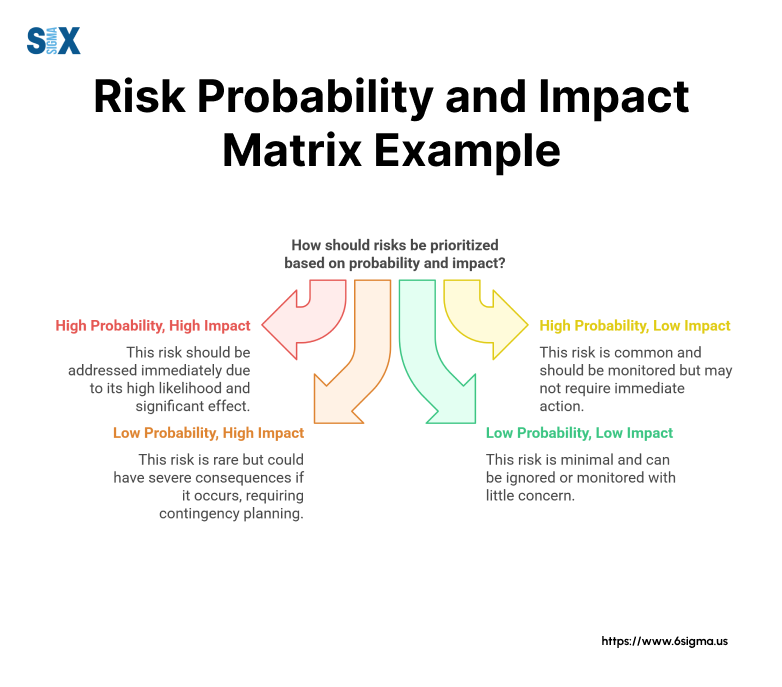
Transform Your Understanding of Risk Analysis
Elevate your Risk Management Skills with Six Sigma Green Belt

SWOT Analysis
SWOT analysis examines internal strengths and weaknesses alongside external opportunities and threats. This technique helps project teams identify potential risks while considering organizational capabilities.
The analysis focuses on four key areas:
- Strengths: Internal capabilities that support risk management
- Weaknesses: Internal limitations that may increase risks
- Opportunities: External factors that could benefit the project
- Threats: External factors that could create project risks
Delphi Technique
The Delphi technique gathers expert opinions through structured rounds of questionnaires. This method proves particularly valuable when dealing with complex or uncertain risk scenarios.
Key steps in the Delphi process:
- Expert panel selection and engagement
- Anonymous feedback collection
- Response analysis and consolidation
- Iterative refinement of assessments
- Final consensus development
Bow-Tie Analysis
Bow-tie analysis provides a visual representation of risk pathways, connecting causes and consequences. This technique helps teams identify prevention and mitigation measures for specific risks.
The analysis examines:
- Left side: Potential causes and preventive controls
- Center: Risk event description
- Right side: Potential consequences and mitigation measures
Expert Judgment
Expert judgment relies on knowledge from experienced professionals to evaluate risks. This technique proves especially valuable when historical data is limited or when dealing with unique project situations.
Experts contribute by:
- Evaluating risk probability levels
- Assessing potential impact severity
- Suggesting appropriate response strategies
- Identifying risk interconnections
- Validating assessment results
Digital Tools and Integration
Modern risk analysis software enhances these traditional techniques by providing:
- Digital collaboration platforms
- Automated assessment tools
- Real-time data visualization
- Historical data analysis
- Report generation capabilities
Project teams should select tools based on:
- Project size and complexity
- Team distribution and location
- Available resources and budget
- Required reporting capabilities
- Integration needs with existing systems
Regular review and updates of these tools ensure their effectiveness throughout the project lifecycle. Teams should document lessons learned and best practices to improve future risk analysis efforts.
Master Risk Analysis Techniques with FMEA Training
Practical Examples of Qualitative Risk Analysis
Real-world applications of qualitative risk analysis demonstrate its value across different industries and project types.
These examples showcase how various organizations implement risk analysis techniques to address specific challenges.
Case Study 1: Enterprise Software Implementation
A multinational corporation undertook a major software implementation project affecting 5,000 users across multiple locations.
The project team applied qualitative risk analysis to identify and manage potential obstacles.
Key Risk Factors Identified:
- User adoption resistance
- Data migration complications
- System integration challenges
- Training program effectiveness
- Network infrastructure capacity
The team used a probability-impact matrix to prioritize these risks.
High-priority items included data migration and user adoption, leading to the development of specific mitigation strategies such as pilot testing and enhanced user communication programs.
Case Study 2: Commercial Building Development
During a 30-story commercial building project, the construction team employed qualitative risk analysis to manage potential delays and safety concerns.
Primary Risk Categories:
- Weather-related delays
- Supply chain disruptions
- Labor availability
- Regulatory compliance
- Safety incidents
The analysis revealed critical risks in supply chain management and regulatory compliance. This led to the implementation of early procurement strategies and regular consultations with local authorities to prevent delays.
Case Study 3: International Conference Planning
An organization planning a 3-day international conference for 1,000 attendees used qualitative risk analysis to ensure smooth execution.
Risk Assessment Focus Areas:
- Venue capacity and facilities
- Speaker availability
- Technical equipment reliability
- Attendee registration systems
- Emergency response protocols
The analysis highlighted technology failures and speaker cancellations as high-probability risks. The team developed contingency plans including backup systems and alternate speaker arrangements.
Common Themes and Lessons of Qualitative Risk Analysis
These case studies reveal several consistent patterns in successful qualitative risk analysis:
Success Factors:
- Early risk identification and assessment
- Regular stakeholder communication
- Clear documentation procedures
- Flexible response strategies
- Continuous monitoring and updates
Digital Implementation Notes
Modern organizations increasingly utilize digital tools to enhance their risk analysis processes:
Technology Applications:
- Cloud-based risk registers
- Real-time collaboration platforms
- Automated notification systems
- Digital documentation management
- Remote assessment capabilities
These tools particularly benefit distributed teams working across different locations and time zones, enabling efficient risk management and response coordination.
The evolution of risk analysis continues to incorporate new considerations such as environmental impact and social responsibility.
Organizations must adapt their analysis methods to address these emerging factors while maintaining project efficiency and effectiveness.
Benefits and Limitations of Qualitative Risk Analysis
Understanding both the advantages and drawbacks of qualitative risk analysis helps project teams make informed decisions about their risk management approach.
This knowledge enables organizations to maximize the benefits while implementing strategies to overcome potential limitations.
Key Advantages
Quick Implementation
The speed of qualitative risk analysis makes it particularly valuable during project planning phases. Teams can rapidly assess and categorize risks without extensive data collection or complex calculations.
Cost-Effective Analysis
Organizations save resources by using straightforward assessment methods that don’t require specialized software or extensive training. This makes qualitative risk analysis accessible to projects of all sizes and budgets.
Stakeholder Engagement
The process encourages participation from various stakeholders through workshops and discussion sessions. This inclusive approach helps build consensus and ensures diverse perspectives are considered in risk assessment.
Flexible Application
Teams can adapt qualitative risk analysis methods to suit different project types and industries. The scalability of this approach makes it suitable for both small initiatives and large-scale programs.
Clear Communication
Risk priorities and mitigation strategies can be easily explained to stakeholders using simple matrices and categorization schemes. This clarity helps maintain alignment among team members and decision-makers.
Limitations and Mitigation Strategies of Qualitative Risk Analysis
Subjective Assessment
The reliance on individual judgment can lead to inconsistent risk evaluations.
Teams can address this by:
- Establishing standardized assessment criteria
- Using multiple evaluators for each risk
- Implementing peer review processes
- Documenting assessment rationales
Limited Precision
Qualitative analysis may not provide the detailed numerical data needed for complex decision-making.
Organizations can supplement their analysis by:
- Conducting follow-up quantitative analysis for critical risks
- Using semi-quantitative scoring systems
- Maintaining historical data for reference
- Regular updating of risk assessments
Bias Influence
Personal experiences and organizational culture might skew risk perceptions.
Mitigation approaches include:
- Engaging external experts for validation
- Using structured assessment frameworks
- Implementing cross-functional review panels
- Providing bias awareness training
Time Sensitivity
Risk assessments may become outdated as project conditions change.
Teams should:
- Schedule regular review sessions
- Monitor trigger conditions
- Update assessments after significant changes
- Maintain dynamic risk registers
Modern Solutions and Adaptations
Digital tools now help address traditional limitations through:
- Automated assessment templates
- Collaborative evaluation platforms
- Real-time update capabilities
- Historical data integration
- Standardized reporting formats
Environmental and social considerations require additional attention in modern risk analysis.
Organizations increasingly incorporate:
- Sustainability impact assessments
- Social responsibility metrics
- Stakeholder feedback mechanisms
- Environmental compliance checks
The effectiveness of qualitative risk analysis often depends on how well organizations address these limitations while leveraging the inherent benefits.
Regular evaluation and adjustment of risk assessment processes ensure continued value for project management efforts.
Conclusion
Qualitative risk analysis remains a fundamental tool in modern project management, providing structured approaches to identify, assess, and manage project risks.
The method’s accessibility and flexibility make it valuable for organizations of all sizes, while its systematic approach ensures consistent risk evaluation across projects.
Project managers have witnessed the evolution of risk analysis from simple probability-impact matrices to sophisticated digital platforms that enable real-time collaboration and assessment.
These advancements have strengthened the effectiveness of qualitative risk analysis while maintaining its core benefits of simplicity and practicality.
Future Trends and Developments in Qualitative Risk Analysis
The field of qualitative risk analysis continues to evolve, shaped by technological advances and changing business needs.
Digital transformation drives several emerging trends in risk analysis practices:
- Integration of Machine Learning
- Remote Collaboration Tools
- Environmental and Social Considerations
- Data-Driven Decision Support
Moving Forward
The success of qualitative risk analysis depends on organizations’ ability to:
- Adapt traditional methods to modern project environments
- Leverage new technologies while maintaining simplicity
- Balance stakeholder needs with risk management requirements
- Incorporate emerging risk factors into assessment frameworks
As project environments become more complex, qualitative risk analysis will continue to provide valuable insights for risk management decisions.
Organizations that embrace new tools and methodologies while maintaining the fundamental principles of risk assessment will be better positioned to handle future challenges.
The ongoing development of risk analysis practices ensures that this essential project management tool remains relevant and effective in an ever-changing business landscape.
Project managers and risk professionals must stay informed about these developments to maximize the value of their risk management efforts.
SixSigma.us offers both Live Virtual classes as well as Online Self-Paced training. Most option includes access to the same great Master Black Belt instructors that teach our World Class in-person sessions. Sign-up today!
Virtual Classroom Training Programs Self-Paced Online Training Programs

